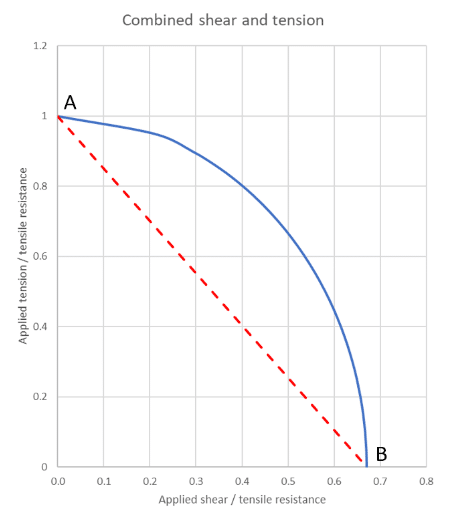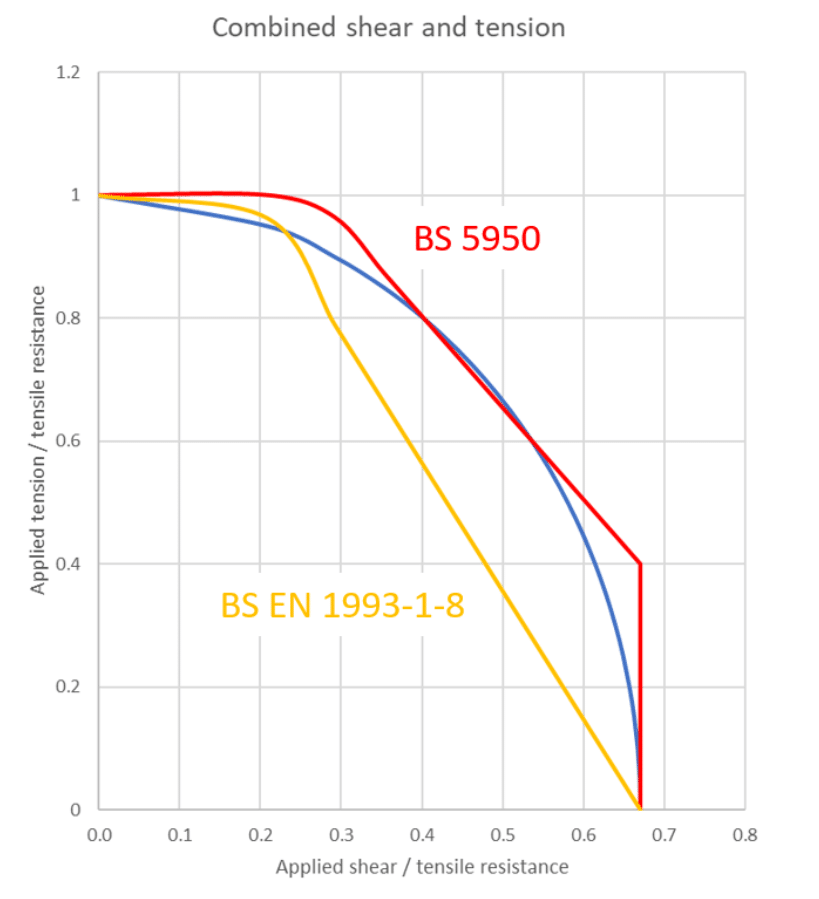BlindBolts subject to combined shear and tension
Blindbolt UK | 8th September 2023
It may seem strange that fixings which are fully loaded in shear can actually also carry tension at the same time, and vice versa, but this is a fact proved by tests and acknowledged by design standards. BlindBolts have been shown by test to behave in the same way as standard fixings and may be designed using the same interaction expressions.
Test results
When fixings are tested under different combinations of shear and bending, strange effects are noted. When the loading is almost all tension (point A on the graph), the bolts fail in tension. When the loading is almost all shear (point B on the graph), the bolts fail in shear.

Point B may appear to be at a strange point on the horizontal axis, but this is simply because the shear resistance of a bolt is approximately 67% of the tension resistance.
It might be expected that for intermediate combinations of shear and tension, the resistance would follow a straight line between points A and B (the red dashed line), but in fact the test resistances follow an elliptical relationship, shown by the blue line.
Structural design codes are drafted to avoid undue conservatism, so have formulas which have been arranged to approximate the blue elliptical curve. Both BS 5950 and BS EN 1993-1-8 have interaction expressions, with slightly different formats.
BS 5950 design rules
When fixings are in combined shear and tension, clause 6.3.4.4 of BS 5950 presents the relationship to be satisfied as:

This is shown as the red curve on the figure below.
BS EN 1993-1-8 design rules
When fixings are in combined shear and tension, Table 3.4 of BS EN 1993-1-8 presents the relationship to be satisfied as:

This is shown as the orange curve on the figure below.

The interaction expression in BS EN 1993-1-8 is more conservative than that in BS 5950. designers working to BS 5950 should not worry – test evidence shows that the BS 5950 rules are safe for use.
BlindBolts in combined shear and bending
It may appear logical to assume that the same rules which are applied to ordinary fixings should be applied to BlindBolts, the interaction naturally being based on the reduced shear and tension resistances calculated for BlindBolts.
To be confident that the rules for ordinary fasteners were appropriate, an extensive series of tests was conducted with a special test apparatus, applying tension and shear force in differing combinations. This test work, the test equipment and the results can be reviewed in SCI Report RT 1303, available from BlindBolt.
The test results revealed that resistances in combined shear and tension were significantly in excess of the resistance limitations imposed by both BS 5950 and BS EN 1993-1-8. The report observes that although a more favourable relationship might be developed for BlindBolts than for ordinary fixings, the usual interaction expressions can be certainly used with confidence. The more favourable approach is possible because the tested shear resistance is significantly higher than the value calculated in accordance with the design standard.
Conclusion
The interaction expressions to be used for BlindBolts under combined shear and tension are precisely the same as those given in the design standards. Physical tests have confirmed that the interaction expressions are appropriate for use with BlindBolts.
Find Your BlindBolt Today By...
... checking out our detailed guide to Blind Bolts by clicking here. You can also find out more about blind bolts by speaking to our expert team today on +44 (01299) 272 955 by emailing enquiries@blindbolt.co.uk.

